Cluster feeding baby whisperer
How To Use Cluster Feeding to Get Baby Sleeping All Night
Read for great tips on how to get baby sleeping through the night using cluster feeding. Read for other great benefits of cluster feeding.
There are many simple things you can do to help your little one sleep through the night or at least sleep more in the night.
Cluster feeding is one of those great tools. If you want baby to sleep through the night, consider the cluster feed.
While it is excellent for night sleep, there are also other benefits.
Keep reading to see what exactly cluster feeding is, find a typical cluster feeding schedule, know good ages for cluster feeding, and learn the benefits of cluster feeding.
Post Contents
- Cluster Feeding Defined
- Cluster Feeding Schedule
- Cluster Feeding Ages
- Benefits of Cluster Feeding
- Longer Night Stretches
- Increases Milk Supply
- Enables Enough Feedings in a Day
- Helps with Fussiness
- Provides More Calories When Needed
- My Cluster Feeding Experiences
- Conclusion
- Related Posts
Cluster Feeding Defined
What is cluster feeding? In short, cluster feeding is feeding baby every two hours.
When you are cluster feeding in order to get longer night stretches of sleep, you would aim for this to be in the evening. You do this in an attempt to get the baby nice and full right before nighttime when you hope to get a longer stretch of sleep from the baby.
Cluster feeding can also happen without the parent driving the cluster feeding. Cluster feeding can happen when baby is having a growth spurt or if there is low milk supply and baby is trying to build it back up. Baby will want to nurse more often in these situations.
If baby’s cluster feeding is due to low milk supply, then baby will want to eat more often until there is enough milk. If baby is eating more often because of growth spurt, then baby will need to do so until the growth spurt is over.
>>>Read all about Growth Spurts here.
In this post, I am talking about when you use cluster feeding intentionally.
Cluster Feeding Schedule
If you are cluster feeding your baby intentionally, then you will be working on a 2. 5-3 hour feeding schedule during the day and will then switch to a 2 hour feeding schedule in the evening hours as you approach the night.
5-3 hour feeding schedule during the day and will then switch to a 2 hour feeding schedule in the evening hours as you approach the night.
You will have two, two-hour feeding cycles. For example, you could do 6 PM, 8 PM, and 10 PM.
Your two hour feeding intervals would be between 6-8 and 8-10. You might have a third two hour feeding interval if you last fed at 4 PM.
Your first feed of your cluster feeds in your cluster feed cycle is the evening feed. This is typically somewhere between 5 and 6 PM. So baby nurses at this time (or bottle feeds) and you go two more hours.
So if it was at 5 PM, you would feed at 5, then 7, and would finish up with a dreamfeed (dreamfeed happens between 10-11 PM. Read all about the basics of a Dreamfeed here).
Cluster Feeding Ages
Cluster feeding can start as soon as you bring baby home from the hospital. You can also start anytime between a few days old and a 2 months old. So yes, you can cluster feed your four day old.
Tracy Hogg, author of the Baby Whisperer (Secrets of the Baby Whisperer: How to Calm, Connect, and Communicate with Your Baby
and The Baby Whisperer Solves All Your Problems: Sleeping, Feeding, and Behavior–Beyond the Basics from Infancy Through Toddlerhood) books, is an advocate for “cluster feeding” your newborn in the evenings.
Hogg recommends stopping cluster feeding by 8 weeks old (Baby Whisperer Solves All Your Problems, page 94). In Secrets of the Baby Whisperer, Hogg suggests starting cluster feeding at six weeks old (page 208) and doesn’t have an ending age.
Always go with what you feel is best for your little one.
Any age of newborn baby is appropriate for cluster feeding. Newborn months are the appropriate period of time for using this routine strategy.
In short, start as soon as you feel it is best for baby and start to consider ending at 8 weeks old. Continue longer if you feel your baby still needs it beyond 8 weeks old.
>>>Read: Ultimate Guide to Stopping Baby Poop at Night
Benefits of Cluster Feeding
There are many benefits to cluster feeding.
Longer Night Stretches
One is that it can help baby sleep longer stretches at night. The idea is you are “tanking up” your baby for some nice nighttime sleep stretches. Read up on my tips to get baby to sleep through the night here. Another great tool along with cluster feeding is the dreamfeed.
Cluster feeding and dream feeding can work really well in conjunction with each other to get baby sleeping through the night.
The Baby Whisperer points out that some babies will only do one or the other, so if you cluster feed, your baby won’t take a dreamfeed. Hogg puts the higher value on the dreamfeed, so if you have to choose one or the other, choose the dreamfeed.
Increases Milk Supply
Another benefit of cluster feeding is it can help keep your milk supply up if you are concerned about it or can help boost your supply and increase milk production if it is dipping for any reason.
If you are breastfeeding, cluster feeding can be a good way to help you have enough breast milk for your baby.
Please note, however, that if your baby does not need to cluster feed and it disrupts your baby but you need milk supply help, you do not need to force cluster feeding.
You can use a breast pump to pump and get some stimulation that way. Do not worry that a pump is not a suitable method for increasing supply.
Always respect baby’s needs.
Enables Enough Feedings in a Day
Another great benefit is that it can help you make sure you get enough feedings in each day. When doing a baby schedule or routine, you want to be mindful that you are getting enough feedings in a 24-hour period.
It can be hard to fit in 8-10 feedings in a 24 hours as Babywise recommends for a newborn without having a bunch in the night when you also really need to be sleeping. Cluster feeding helps you sneak some extra feedings in the daytime.
Always remember to watch diaper output and make sure baby is getting enough wet diapers and dirty diapers each day for her age.![]() You always want to pay attention to hunger cues and monitor baby’s development.
You always want to pay attention to hunger cues and monitor baby’s development.
>>>Read: Hunger Cues: How To Know if Baby Is Hungry
Helps with Fussiness
Many people also find feeding a fussy baby more often when the baby is fussy in the evening can really help.
Fussy evenings are normal with infants, but some babies take it beyond fussiness and it turns to witching hour. If your baby has witching hour, cluster feeding can sometimes help.
Be sure, however, you are not over-feeding your baby and causing tummy issues. You might think you are offering cluster feeding for comfort and it is actually causing more fussiness. You also do not need to turn mom into a pacifier.
Read my post on how to help your baby through the witching hour for lots of great ideas.
Provides More Calories When Needed
Cluster feeding can also add more calories to the day if your baby is struggling with weight gain. Adding another feeding in the early evening can help ensure baby is getting enough calories each day.
My Cluster Feeding Experiences
I never heard about the Baby Whisperer until I was pregnant with McKenna. Well, once I had learned about her, I thought I might have seen her on a television show when I was pregnant with Brayden, but I can’t be sure. When I was pregnant with McKenna, I decided to read the book to learn more about her methods.
When Brayden was a baby and we were new parents, despite not knowing about the Baby Whisperer, we did some “tanking up” and fed every couple of hours in the evening, but he was older when we did it. He was more around 3/4 months old.
He just obviously was more hungry in the evening so I fed him more often.
It was a similar situation with Kaitlyn. We did the two hour interval in the evening hours when she was a newborn. It just made sense with the schedule.
With McKenna, I knew about the official term “cluster feeding.” We did cluster feeding starting around 8 weeks old. You can read about our experience in this McKenna newborn summary and you can read about when we ended cluster feeding in this McKenna newborn summary.
Cluster feeding seemed to help and it definitely didn’t hurt anything while we did it. If you find you are looking for ideas to help give baby that extra bit she needs to sleep through the night, cluster feeding just might be your answer!
Related Posts
- How To Solve Your Baby’s Nighttime Sleep Issues
- How To Tell if Baby is Getting a Full Feeding
- How To Get Baby to Sleep Through the Night
- Is Baby’s Night Waking from Hunger?
This post originally appeared on this blog in June 2019
How To Use Cluster Feeding to Get Baby Sleeping All Night
Read for great tips on how to get baby sleeping through the night using cluster feeding. Read for other great benefits of cluster feeding.
There are many simple things you can do to help your little one sleep through the night or at least sleep more in the night.
Cluster feeding is one of those great tools. If you want baby to sleep through the night, consider the cluster feed.
While it is excellent for night sleep, there are also other benefits.
Keep reading to see what exactly cluster feeding is, find a typical cluster feeding schedule, know good ages for cluster feeding, and learn the benefits of cluster feeding.
Post Contents
- Cluster Feeding Defined
- Cluster Feeding Schedule
- Cluster Feeding Ages
- Benefits of Cluster Feeding
- Longer Night Stretches
- Increases Milk Supply
- Enables Enough Feedings in a Day
- Helps with Fussiness
- Provides More Calories When Needed
- My Cluster Feeding Experiences
- Conclusion
- Related Posts
Cluster Feeding Defined
What is cluster feeding? In short, cluster feeding is feeding baby every two hours.
When you are cluster feeding in order to get longer night stretches of sleep, you would aim for this to be in the evening. You do this in an attempt to get the baby nice and full right before nighttime when you hope to get a longer stretch of sleep from the baby.
Cluster feeding can also happen without the parent driving the cluster feeding. Cluster feeding can happen when baby is having a growth spurt or if there is low milk supply and baby is trying to build it back up. Baby will want to nurse more often in these situations.
If baby’s cluster feeding is due to low milk supply, then baby will want to eat more often until there is enough milk. If baby is eating more often because of growth spurt, then baby will need to do so until the growth spurt is over.
>>>Read all about Growth Spurts here.
In this post, I am talking about when you use cluster feeding intentionally.
Cluster Feeding Schedule
If you are cluster feeding your baby intentionally, then you will be working on a 2.5-3 hour feeding schedule during the day and will then switch to a 2 hour feeding schedule in the evening hours as you approach the night.
You will have two, two-hour feeding cycles. For example, you could do 6 PM, 8 PM, and 10 PM.
Your two hour feeding intervals would be between 6-8 and 8-10. You might have a third two hour feeding interval if you last fed at 4 PM.
Your first feed of your cluster feeds in your cluster feed cycle is the evening feed. This is typically somewhere between 5 and 6 PM. So baby nurses at this time (or bottle feeds) and you go two more hours.
So if it was at 5 PM, you would feed at 5, then 7, and would finish up with a dreamfeed (dreamfeed happens between 10-11 PM. Read all about the basics of a Dreamfeed here).
Cluster Feeding Ages
Cluster feeding can start as soon as you bring baby home from the hospital. You can also start anytime between a few days old and a 2 months old. So yes, you can cluster feed your four day old.
Tracy Hogg, author of the Baby Whisperer (Secrets of the Baby Whisperer: How to Calm, Connect, and Communicate with Your Baby
and The Baby Whisperer Solves All Your Problems: Sleeping, Feeding, and Behavior–Beyond the Basics from Infancy Through Toddlerhood) books, is an advocate for “cluster feeding” your newborn in the evenings.
Hogg recommends stopping cluster feeding by 8 weeks old (Baby Whisperer Solves All Your Problems, page 94). In Secrets of the Baby Whisperer, Hogg suggests starting cluster feeding at six weeks old (page 208) and doesn’t have an ending age.
Always go with what you feel is best for your little one.
Any age of newborn baby is appropriate for cluster feeding. Newborn months are the appropriate period of time for using this routine strategy.
In short, start as soon as you feel it is best for baby and start to consider ending at 8 weeks old. Continue longer if you feel your baby still needs it beyond 8 weeks old.
>>>Read: Ultimate Guide to Stopping Baby Poop at Night
Benefits of Cluster Feeding
There are many benefits to cluster feeding.
Longer Night Stretches
One is that it can help baby sleep longer stretches at night. The idea is you are “tanking up” your baby for some nice nighttime sleep stretches. Read up on my tips to get baby to sleep through the night here. Another great tool along with cluster feeding is the dreamfeed.
Read up on my tips to get baby to sleep through the night here. Another great tool along with cluster feeding is the dreamfeed.
Cluster feeding and dream feeding can work really well in conjunction with each other to get baby sleeping through the night.
The Baby Whisperer points out that some babies will only do one or the other, so if you cluster feed, your baby won’t take a dreamfeed. Hogg puts the higher value on the dreamfeed, so if you have to choose one or the other, choose the dreamfeed.
Increases Milk Supply
Another benefit of cluster feeding is it can help keep your milk supply up if you are concerned about it or can help boost your supply and increase milk production if it is dipping for any reason.
If you are breastfeeding, cluster feeding can be a good way to help you have enough breast milk for your baby.
Please note, however, that if your baby does not need to cluster feed and it disrupts your baby but you need milk supply help, you do not need to force cluster feeding.
You can use a breast pump to pump and get some stimulation that way. Do not worry that a pump is not a suitable method for increasing supply.
Always respect baby’s needs.
Enables Enough Feedings in a Day
Another great benefit is that it can help you make sure you get enough feedings in each day. When doing a baby schedule or routine, you want to be mindful that you are getting enough feedings in a 24-hour period.
It can be hard to fit in 8-10 feedings in a 24 hours as Babywise recommends for a newborn without having a bunch in the night when you also really need to be sleeping. Cluster feeding helps you sneak some extra feedings in the daytime.
Always remember to watch diaper output and make sure baby is getting enough wet diapers and dirty diapers each day for her age. You always want to pay attention to hunger cues and monitor baby’s development.
>>>Read: Hunger Cues: How To Know if Baby Is Hungry
Helps with Fussiness
Many people also find feeding a fussy baby more often when the baby is fussy in the evening can really help.
Fussy evenings are normal with infants, but some babies take it beyond fussiness and it turns to witching hour. If your baby has witching hour, cluster feeding can sometimes help.
Be sure, however, you are not over-feeding your baby and causing tummy issues. You might think you are offering cluster feeding for comfort and it is actually causing more fussiness. You also do not need to turn mom into a pacifier.
Read my post on how to help your baby through the witching hour for lots of great ideas.
Provides More Calories When Needed
Cluster feeding can also add more calories to the day if your baby is struggling with weight gain. Adding another feeding in the early evening can help ensure baby is getting enough calories each day.
My Cluster Feeding Experiences
I never heard about the Baby Whisperer until I was pregnant with McKenna. Well, once I had learned about her, I thought I might have seen her on a television show when I was pregnant with Brayden, but I can’t be sure. When I was pregnant with McKenna, I decided to read the book to learn more about her methods.
When I was pregnant with McKenna, I decided to read the book to learn more about her methods.
When Brayden was a baby and we were new parents, despite not knowing about the Baby Whisperer, we did some “tanking up” and fed every couple of hours in the evening, but he was older when we did it. He was more around 3/4 months old.
He just obviously was more hungry in the evening so I fed him more often.
It was a similar situation with Kaitlyn. We did the two hour interval in the evening hours when she was a newborn. It just made sense with the schedule.
With McKenna, I knew about the official term “cluster feeding.” We did cluster feeding starting around 8 weeks old. You can read about our experience in this McKenna newborn summary and you can read about when we ended cluster feeding in this McKenna newborn summary.
ConclusionCluster feeding seemed to help and it definitely didn’t hurt anything while we did it. If you find you are looking for ideas to help give baby that extra bit she needs to sleep through the night, cluster feeding just might be your answer!
Related Posts
- How To Solve Your Baby’s Nighttime Sleep Issues
- How To Tell if Baby is Getting a Full Feeding
- How To Get Baby to Sleep Through the Night
- Is Baby’s Night Waking from Hunger?
This post originally appeared on this blog in June 2019
The child began to breastfeed more often.
 This is fine?
This is fine? This is the period in a baby's life when he begins to breastfeed more often. For example, if yesterday your child ate an average of once every two hours, and today he requires a breast every half an hour or an hour, we are talking about cluster or group feeding. This is a temporary change in the feeding regime, however, parents are unlikely to be happy with such changes and may think that they are doing something wrong. We hasten to reassure you: cluster feeding is normal.
This usually happens within the first 28 days of a child's life. As David Hill, Fellow of the American Academy of Pediatrics, says, the first "attack" of cluster feeding usually occurs on the 10-12th day of life, and then repeats in the region of three months. But in general, cluster feedings are typical for the entire first half of a baby's life.
Most often, cluster feedings occur in the late afternoon, when the baby is tired of external stimuli and wants to calm down and fall asleep. Cluster feedings often accompany growth and developmental spurts. Sometimes they can last all day.
Cluster feedings often accompany growth and developmental spurts. Sometimes they can last all day.
The first weeks and months of a baby's life are a difficult time for him, because he is constantly growing and developing, accepting new conditions of life outside the womb, adapting to the outside world. To do this, he needs not only to get food regularly, but also to calm down, because this big world is such a complicated thing.
Sucking and being at the mother's breast is a natural need for the baby, so he uses cluster feedings not only to eat, but also to get close contact with the mother. So don't get mad at him, he really needs it. And do not listen to those who say that "that way he will make a dummy out of you." Won't. Listen to yourself and the child, you are doing everything right.
The good news is that there is evidence that this behavior in a child precedes longer sleep (we're talking about four to five hours). Why, it's a whole chasm of uninterrupted sleep when you have a newborn!
Why, it's a whole chasm of uninterrupted sleep when you have a newborn!
Yes, indeed, cluster feedings can exhaust a mother. But, as the same Hill says, they are important for her, especially if they occur at the initial stage of motherhood. The fact is that by frequent application, the baby stimulates the production of milk, thus helping the mother to quickly establish full lactation.
Of course, the baby needs maternal care and warmth, skin-to-skin contact, but you should not forget about yourself during this exhausting period of group feeding! More precisely, it is strictly forbidden, otherwise you risk bringing yourself to emotional exhaustion. Here's what can be done.
Don't blame yourself or your child. He is all right, all babies have such days, and you are doing everything right - offering him what he needs most now.
Do not forget to drink and eat , because your body is now intensively establishing lactation, which means it consumes a large amount of energy. Eat well and don't limit yourself to kuro-buckwheat.
Eat well and don't limit yourself to kuro-buckwheat.
Sleep between feeds . Facebook and Instagram can wait. Especially if cluster feedings caught you at night, and the baby wakes up every hour. Yes, it will seem to you that it is easier not to sleep at all than to spend time on short sleep sessions, but this is not so.
Connect partner . Yes, you may think that this is rather pointless, because he does not have breasts with milk. But he can carry the baby in his arms while you drink tea or spend time in the shower - during this period it is important to give yourself a little respite.
Don't listen to the "experts" . You will definitely be advised to put the child down and "let him scream" or do something else so that "God forbid, spoil him." But you shouldn't do that. We now know more about children and their needs than ever before. So: cluster feedings will not spoil your baby. He really needs them. In any case, more than senseless motion sickness, attempts to distract and hiss are more necessary.
He really needs them. In any case, more than senseless motion sickness, attempts to distract and hiss are more necessary.
It is believed that one episode of grouped feedings should not exceed two days, and the application itself should not exceed an hour. If the baby “hangs” on the chest for an hour and this has been happening for two days, you need to contact a lactation consultant or a pediatrician you trust.
We asked Daria Utkina, a doula and mother-and-child care consultant, to talk about cluster feeding.
Not all babies go through this period, but most do. It seems to me that knowing in itself that this is a physiological norm, and not an epic fail in becoming a milk fairy, already gives a lot of peace of mind. Often women worry that the reason for cluster feedings is the notorious “not enough milk”, although the child has just enough of everything.
Speaking of support, it's very cool when there are people nearby who also know that cluster feeding is a variant of the norm and you don't have to fight with it. Because even a confident and informed mother will be disturbed by the constant background anxiety of relatives. And if this is the first baby and everything is still completely new, then any comments on the topic “something is not working out for you”, “something is wrong with the child” will fall into the most vulnerable point.
Because even a confident and informed mother will be disturbed by the constant background anxiety of relatives. And if this is the first baby and everything is still completely new, then any comments on the topic “something is not working out for you”, “something is wrong with the child” will fall into the most vulnerable point.
Evening time can also be planned in advance, taking into account the baby hanging on the chest. Arrange with a partner to come to the beginning of vigils, call a postpartum doula or a friend / mother / anyone to be around.
On the contrary, it helps some women to break the stereotype about crazy evenings at home, pack the baby in a sling where he can feed non-stop, and go out into the world.
Well, adjust expectations all the time. Cluster feedings become a problem when the idea sits in your head that a baby usually eats at least once an hour, or even every three hours. And when everything happens differently, it makes you reconsider your ideas not only about babies, but also about your life with them.
And when everything happens differently, it makes you reconsider your ideas not only about babies, but also about your life with them.
Many of my clients find it helpful to remind themselves of "one thing a day." Especially for those who are accustomed to work tirelessly and assumed that while the baby was sleeping and eating, it would be possible to continue almost in the same rhythm.
Plus, sometimes it happens that cluster feedings are just situations where a child for some reason (inefficient attachment, a short bridle, for example) has to be on the breast all the time to get the right amount of milk. In this case, it would be good to call a consultant on breastfeeding and find out what is the reason.
During cluster feedings, the mother has a huge responsibility and may feel overwhelmed, exhausted and frustrated. Obviously, dads can't offer to help feed their baby, but there are some important ways they can help moms.
Get up with your mother. This is really important, she will not feel so lonely if the partner tries to cheer her up during feeding (and at the same time not fall asleep next to her).
Bathe, walk, entertain the child (and also his brothers and sisters). Cluster feeding will be much easier for mom if she can focus only on this.
Take on household chores. Clutter in the house is unlikely to help you stay calm. Conversely, if household chores are in order, mom will be less anxious on busy cluster feeding days.
No. What mother eats does not affect the amount of milk. There are no official lists of prohibited or permitted foods during feeding. If the mother or child does not have allergic reactions, then you can eat whatever you want, and even drink two small cups of coffee a day. We hope it's not cold!
Difficulty feeding the baby
Listen to the audio version
- listen on the Apple Podcasts platform
- listen on the Google Podcasts platform
all the time naughty and worried, and you don’t even have time to go to the toilet. It is possible that you are faced with cluster feeding.
It is possible that you are faced with cluster feeding.
Greetings! My name is Yulia Zharikova, I am a pediatric neonatologist , and today we will talk about how to survive during cluster feeding and why it is needed.
During cluster feeding, the baby needs mother's breast after a short time within a few hours. This phenomenon often occurs in the late afternoon. But do not be surprised if it overtakes you at any time of the day. Cluster feeding is a physiological phenomenon that lasts from a few hours to 2 days. It has a physiological basis. What kind?
During the first year of life after birth, the baby goes through several threshold stages in its development. Most crucial moments fall in the first six months. Currently the child needs more nutrients. The mechanism of cluster feeding is the natural stimulation of breast milk production.
On the other hand, suckling soothes the baby and gives him a sense of security and calm. Cluster feeding is good for the baby. First, the baby gets extra milk. Secondly, suckling gives him a sense of security and comfort, because he is next to his mother. Thirdly, after cluster feeding, the child sleeps longer and calmer.
Cluster feeding is good for the baby. First, the baby gets extra milk. Secondly, suckling gives him a sense of security and comfort, because he is next to his mother. Thirdly, after cluster feeding, the child sleeps longer and calmer.
I understand that this is another exam for a woman, so let's take care of how to benefit our child and survive in this.
Ask a loved one for help: bring a glass of water, a snack, or just be with you and say a few kind words. Drink plenty of fluids. Learn to recognize the early warning signs of a baby's hunger: snapping lips, quick and casual sucking on the nipple, and then pushing it out of the mouth. This will help you plan your time. If cluster feeding occurs suddenly, deal with it.
In order not to be exhausted, take care of food that does not need to be cooked. For example, whole grain bread, butter, sweet tea, apples, etc. Remember that your comfort comes first: choose a comfortable place for yourself, keep books, TV remote control, tablet, etc. nearby.
nearby.
Do not even think that there is no milk in the breast. It definitely is, because the mammary glands never become empty.
Most of the problems of the baby that young parents face are related to the immaturity of his nervous system. For example, spitting up after eating. Naturally, this scares parents, so the doctor is often asked: why does the child spit up, how to prevent or reduce spitting up, is there any medicine for spitting up?
Let's talk about regurgitation in babies.
As usual, let's first turn to knowledge. The body of children differs from the body of adults not only in size. First, the baby's stomach lies horizontally. Secondly, the baby is born with immature nervous regulation of muscle function. Therefore, food easily passes from the stomach into the esophagus and vice versa, it is difficult to pass into the intestines. Swallowing and movements of the stomach muscles are not coordinated. This is also important to remember because almost all the time the baby lies on his back. Thirdly, already at the age of two weeks, the baby eats a fairly large amount of food compared to its weight. Just imagine that your lunch will be equal to 1/5 of your body weight ...
Thirdly, already at the age of two weeks, the baby eats a fairly large amount of food compared to its weight. Just imagine that your lunch will be equal to 1/5 of your body weight ...
Regurgitation is facilitated by a violation of the speed of feeding, when the baby suckles too quickly. This is especially true for bottle feeding.
What can you do to reduce spitting up?
Pay attention to the sucking speed. Breastfeeding babies suck more slowly, and it is easier to do it from a bottle, so the speed is greater. Make it a rule to interrupt the baby two or three times and wait 1 minute for the baby to burp. If you are a bottle feeder, choose a suitable nipple. The child should suck out the formula with some effort.
After feeding is over, carry the baby in an upright position again and then place it on the right side of the crib. Raise the headboard 30 degrees. Keep in mind that spitting up and vomiting can be symptoms of an illness that require the advice of a doctor.
What to pay attention to?
The main sign of vomiting is the active expulsion of milk from the stomach, in which you will see the tension of the abdominal muscles. Be sure to pay attention to the general condition of the child. If your baby is crying painfully, eating poorly, looking unwell, and not gaining weight, don't waste your time. The doctor, even in case of diseases of the stomach and esophagus, first of all, will give recommendations on the technique of feeding, and then prescribe a medicine. Food impurities and herbs do not lead to success.
The baby is growing and his nervous system is gradually maturing. Therefore, at about the age of 6 months, regurgitation disappears on its own.
In the first month of life, not only do you get used to being a mom, but the baby also adapts to life. It is not so easy for his internal organs to adapt to new conditions, especially for the intestines. Therefore, we will pay special attention to this most important organ, because often the health of the baby and the peace of mind of his parents depend on his work.
What is lactase deficiency will help you figure out what to do if you suspect your child has it.
I'll start with physiology. The main processes of digestion do not take place in the stomach, as many believe, but in the intestines. It is in the small intestine that the lactase enzyme breaks down the milk sugar lactose into two nutritional molecules: galactose and glucose. This is a powerful drain of energy for the rapid growth and development of the baby in the first year of life, and glucose is also the main nutrient for the brain. In addition, this enzyme controls the lactobacilli living in your child's intestines. When their quantity is normal, they help digestion and assimilation of milk. With a lack of lactase, the number of lactobacilli increases sharply, and their excessive activity leads to fermentation and the formation of gases in the child.
What does this lead to?
Every time shortly after feeding, the baby's tummy grows in size from excess gas, the mother is frightened by too frequent, rare, and sometimes even frothy stools and the baby's constant spitting up, and the baby suffers from pain and cannot calm down. This condition is called colic. I don’t know if I will reassure you, but you are definitely not alone, most babies and their parents experience temporary discomfort from a lack of lactase.
This condition is called colic. I don’t know if I will reassure you, but you are definitely not alone, most babies and their parents experience temporary discomfort from a lack of lactase.
How dangerous is temporary lactase deficiency for a baby?
Transient lactase deficiency is not considered a disease. Over time, more and more of the enzyme is produced, and the symptoms slowly decrease until they subside completely. But there are cases when a lack of lactase significantly changes the internal environment of the intestine, the stool becomes too acidic and can irritate and even damage the intestinal wall. Fortunately, this rarely happens. In most babies, temporary lactase deficiency does not affect their health.
“My baby is three weeks old. After each feeding, she cries, sleeps badly, gaziki interfere, and so on all the time. I already have a feeling of guilt and fear of every feeding. Nothing helps: neither espumizans, nor all sorts of plantexes ... Advise what to do? This is a question from the moms forum.
What, first of all, depends on the mother if the child does not have enough lactase?
Let me briefly remind you that, in general, milk in the mammary gland is conditionally divided into anterior and posterior. And it is in the front portions that there is a lot of milk sugar, which gives the milk a pleasant taste, but requires a lot of the lactase enzyme for absorption. Until three or four months, the lactase enzyme is produced little, so the child suffers from pain and stool disorders.
How to overcome temporary lactase deficiency?
First, I propose to arrange breastfeeding of the child. Feed milk from one breast until he sucks all the milk. Keep in mind, the more often you express milk, the more milk sugar it has . To reduce the number of pumping times, put your baby on the same breast every two to three hours. So you regulate not only the quantity of milk, but also its quality.
Do not breastfeed your baby for any reason. If you give this time, then the baby will properly latch on to the breast and receive hind milk, and the stomach will be calmer. Remember that pain is a sign that the baby is not breastfeeding properly . A sign that you are doing everything right will be a pleasant and painless feeding for you, as well as nipples without cracks. Don't believe that life is painful, life is practice.
If you give this time, then the baby will properly latch on to the breast and receive hind milk, and the stomach will be calmer. Remember that pain is a sign that the baby is not breastfeeding properly . A sign that you are doing everything right will be a pleasant and painless feeding for you, as well as nipples without cracks. Don't believe that life is painful, life is practice.
Be careful when using breast pads as they make it harder to latch on properly.
Don't skip the night feeding because the fatter hindmilk is produced at night. Do not interrupt breastfeeding immediately after the baby has eaten: let him suck a little more. And know that sometimes a few days of proper feeding are enough to improve the stool and bowel function of the baby.
It takes 3-4 months for the lactase enzyme to fully mature. We are all very worried when something is not being repaired in our children, naturally we want to help, but remember that only a doctor can establish diagnoses, but proper care depends solely on you.
Listen to the audio version
- listen on Apple Podcasts
- listen on Google Podcasts
There are legends and myths about colic in babies. How many are afraid, they are fighting, they are trying to warn. More often they appear precisely during adaptation after birth. They do not belong to the diseases of the child, but sometimes they significantly injure the psyche of the parents.
How to relieve colic in babies is one of the most common queries in adults. While suckling on either the breast or the formula bottle, babies swallow air, which irritates the stomach and causes painful cramps. First of all, think that the baby swallowed air if he starts to fuss and suck quickly. Stop feeding and let the baby burp and he will become calm.
There are several techniques, but we'll look at the most common one.
How can you help your baby?
Cover your shoulder with a piece of cloth to keep your clothes clean. Take the child in your arms so that his tummy is towards your chest, and your palm supports his buttocks. Bring the fingers of the second hand together and for one minute slowly clap the baby between the shoulder blades: first up the back, and then down the same way. Splash can be replaced by soft rubbing in the same directions. Press your palm against the baby's back firmly but gently. The main thing is to avoid rough movements so as not to harm.
Take the child in your arms so that his tummy is towards your chest, and your palm supports his buttocks. Bring the fingers of the second hand together and for one minute slowly clap the baby between the shoulder blades: first up the back, and then down the same way. Splash can be replaced by soft rubbing in the same directions. Press your palm against the baby's back firmly but gently. The main thing is to avoid rough movements so as not to harm.
Be aware that it is not always possible to hear the sound of burping, so be guided by the behavior of the child. During a feed, I recommend letting the baby burp somewhere in the middle and after the feed is over. Watch your child and after a short practice, you will understand what is best and how much time it takes with your child.
Keep in mind that no one has yet researched how bloating remedies work in babies, it is highly doubtful whether they work at all. Don't worry, if you put in the effort, you can get by without it.
Giving a child a chance to burp is also a great opportunity to once again take the child in your arms, talk to him, in a word, it is an opportunity to show sympathy to the child about his pain and troubles, and what could be more valuable?
And remember, breastfed babies swallow less air than bottle-fed babies.
Modern doctors believe that the problem of colic is due to a digestive problem and a lack of enzymes. As a result, excess gases form in the intestines, so the baby cries. Most often, this condition occurs in the late afternoon, lasts at least three hours a day for three months. If you are in the subject, then this program is for you.
If colic is really caused by excess gas, how can we alleviate the child's condition?
Lay your baby on your stomach for three to five minutes before each daily feed. Do not be afraid that the muscles of the neck are not yet sufficiently developed, the kids turn their heads perfectly so that they can breathe. While the child is lying on his stomach, with your thumbs, gently walk once along his spine, then turn the baby on his back and gently massage the elbow and knee joints and feet with care. But do not get carried away, remember that your only goal is to calm the baby.
While the child is lying on his stomach, with your thumbs, gently walk once along his spine, then turn the baby on his back and gently massage the elbow and knee joints and feet with care. But do not get carried away, remember that your only goal is to calm the baby.
If your baby is crying shortly after a feed, try the following light exercises to make it easier for gas to pass out of the intestines. Fix the baby's legs bent at the knees with your fingers, then make three to five movements like on a bicycle. Straighten the baby's legs as far as possible, lift them up and push them towards the tummy without undue effort. Often during such an exercise, you can hear the release of gases, and the child calms down. Don't forget about skin-to-skin contact - this is probably the best pain reliever for a child.
And now about what not to do.
So-called dynamic gymnastics exercises are a bad idea. For sudden and too active movements can lead to shaken baby syndrome. YouTube is definitely not an assistant for you: massage of the abdomen does not affect the amount of enzymes, but by chance the internal organs can be damaged, do it not for long and gently.
YouTube is definitely not an assistant for you: massage of the abdomen does not affect the amount of enzymes, but by chance the internal organs can be damaged, do it not for long and gently.
There are several theories about the causes of colic in infants. Now there are more and more substantiated facts about the connection between colic and the degree of maturity of the child's brain. Therefore, remember that neither massage nor exercise, and even more so - special drops, are not universal remedies and only help children with temporary digestive problems. Most importantly, stay calm and provide care that keeps your child safe.
“Recently, the baby has crusts on her cheeks, which have already spread to her forehead. I went to an allergist, and she said that it was an allergy to milk, and she picked up a diet for me. I had to give up the usual products, but the baby got better, ”such stories can be read on many forums, where quite often young mothers raise the topic of babies’ allergies to breast milk.
I will explain why it occurs and what should be done first of all when it appears.
Diet for mom.
True milk protein allergy occurs in only 6% of children. And in addition to skin rashes, it is accompanied by other symptoms, such as abdominal cramps, vomiting, diarrhea.
Mom or dad often has allergies. The problem is that they not only diagnose it themselves and the child, but also independently prescribe a strict diet for the baby, nutritional supplements, and constantly change milk formulas. And this is already harmful to the health of the baby.
What to do if you suspect a baby is allergic to breast milk?
Do not rush to transfer him to artificial feeding. Keep in mind that soy or goat milk based formulas also trigger an allergic reaction, as do rice based formulas that are just now being researched. At the same time, both soy and rice cause inflammation of the small intestine, and this already reduces the quality of life of the baby.
First, avoid milk, butter, any kind of cheese, and food prepared with animal fat, such as baked goods. Kefir, fermented baked milk and yoghurts are also not for you yet. Exclude beef from meat.
Feeding according to the rules.
Before feeding your baby, express the first portion, which is rich in milk sugar, and let him suck out the back milk. Do not express a lot of milk, so as not to provoke hyperlactation. These simple methods are very effective. Often they are enough to improve the health of the baby. Then mom can relax the diet.
Gradually introduce beef and hard cheese into your diet. Follow the rule: one new product every three days. The only exceptions are whole milk and pastries. They are banned!
Allergies are often presented as something mysterious and dangerous. And many people think that it is very easy to diagnose and cure it. Unfortunately, it is not. And advice from the forum for this is not enough. This work is very complex.











